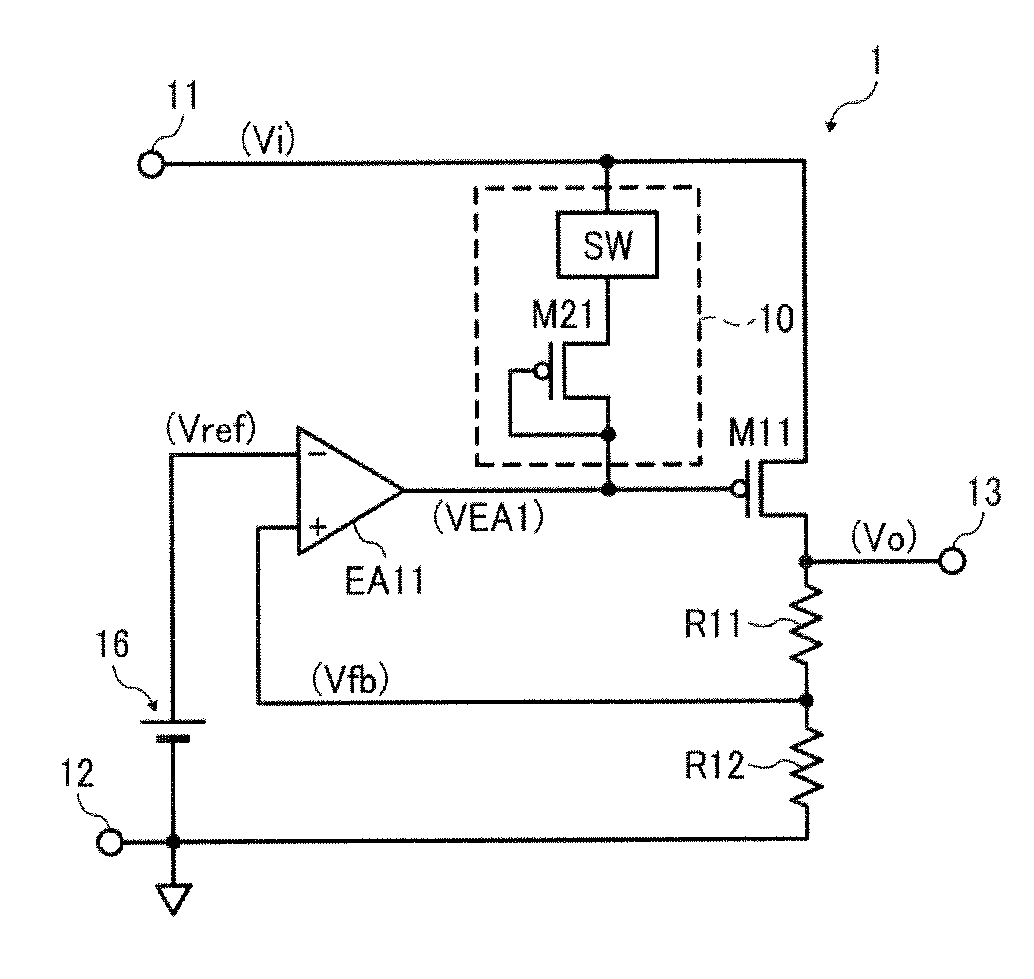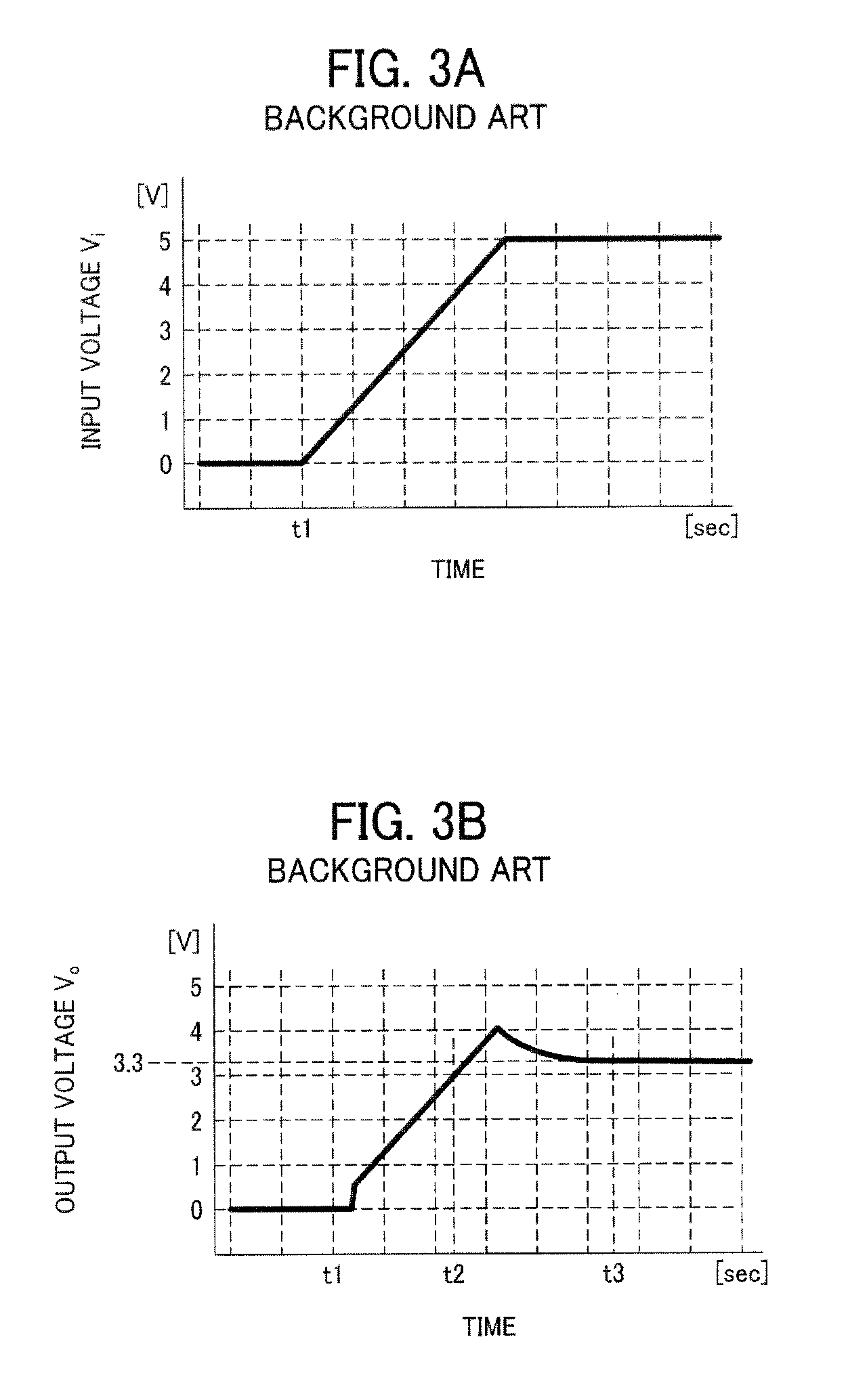Constant voltage regulator
a constant voltage regulator and constant voltage technology, applied in the direction of electric variable regulation, process and machine control, instruments, etc., can solve the problems of discharge circuit , overshoot protection provided by the comparator , runaway or other failure of the load circuit supplied therewith
- Summary
- Abstract
- Description
- Claims
- Application Information
AI Technical Summary
Benefits of technology
Problems solved by technology
Method used
Image
Examples
first embodiment
[0056]FIG. 8 is a circuit diagram schematically illustrating a constant voltage regulator 1 according to this patent specification.
[0057]As shown in FIG. 8, the constant voltage regulator 1 comprises a series regulator for power supply control in electronic devices, such as personal computers, cellular phones, and the like, which converts an input voltage Vi supplied between an input terminal 11 and a ground terminal 12 to a regulated, constant output voltage Vo for output to an output terminal 13 connected to load circuitry that operates with a rated voltage of, for example, 3.3 volts.
[0058]The voltage regulator 1 includes a driver transistor M11, being a p-channel metal-oxide semiconductor (PMOS) device, having a source terminal thereof connected to the input terminal 11 and a drain terminal thereof connected to the output terminal 13; a pair of voltage divider resistors R11 and R12 connected in series between the output terminal 13 and the ground terminal 12 to form a feedback ge...
second embodiment
[0078]FIG. 12 is a circuit diagram schematically illustrating the constant voltage regulator 1 according to this patent specification.
[0079]As shown in FIG. 12, the overall configuration of the present embodiment is similar to that depicted in FIG. 8, except that the differential gain controller 10 includes a pair of first and second, diode-connected PMOS transistors M24 and M25, instead of a single diode-connected transistor M21, each connected in series with the switch SW.
[0080]Specifically, in the present embodiment, the first differential amplifier EA11 has a substantially symmetrical configuration including a differential pair of n-channel metal-oxide semiconductor (NMOS) transistors M12 and M13, the former having its gate terminal connected to the reference voltage generator 16, and the latter having its gate terminal connected to the feedback node between the voltage divider resistors R11 and R12; a current-mirror active load formed of a pair of PMOS transistors M14 and M15, ...
third embodiment
[0091]FIG. 14 is a circuit diagram schematically illustrating the constant voltage regulator 1 according to this patent specification.
[0092]As shown in FIG. 14, the overall configuration of the present embodiment is similar to that depicted in FIG. 8, except that the differential gain controller 10 derives a current for conduction to the gate of the driver transistor M11 from the output terminal 13 instead of the input terminal 11 of the voltage regulator 1.
[0093]Specifically, in the present embodiment, the switch SW is disposed between the output terminal 13 and the output of the first differential amplifier EA11. The diode-connected transistor M21 has a source terminal thereof connectable to the output terminal 13 via the switch SW, and gate and drain terminals thereof connected together to the output of the differential amplifier EA11.
[0094]In such a configuration, the gain controller 10 controls the gain G of the first differential amplifier EA11 in a manner similar to that depi...
PUM
 Login to View More
Login to View More Abstract
Description
Claims
Application Information
 Login to View More
Login to View More - R&D
- Intellectual Property
- Life Sciences
- Materials
- Tech Scout
- Unparalleled Data Quality
- Higher Quality Content
- 60% Fewer Hallucinations
Browse by: Latest US Patents, China's latest patents, Technical Efficacy Thesaurus, Application Domain, Technology Topic, Popular Technical Reports.
© 2025 PatSnap. All rights reserved.Legal|Privacy policy|Modern Slavery Act Transparency Statement|Sitemap|About US| Contact US: help@patsnap.com



